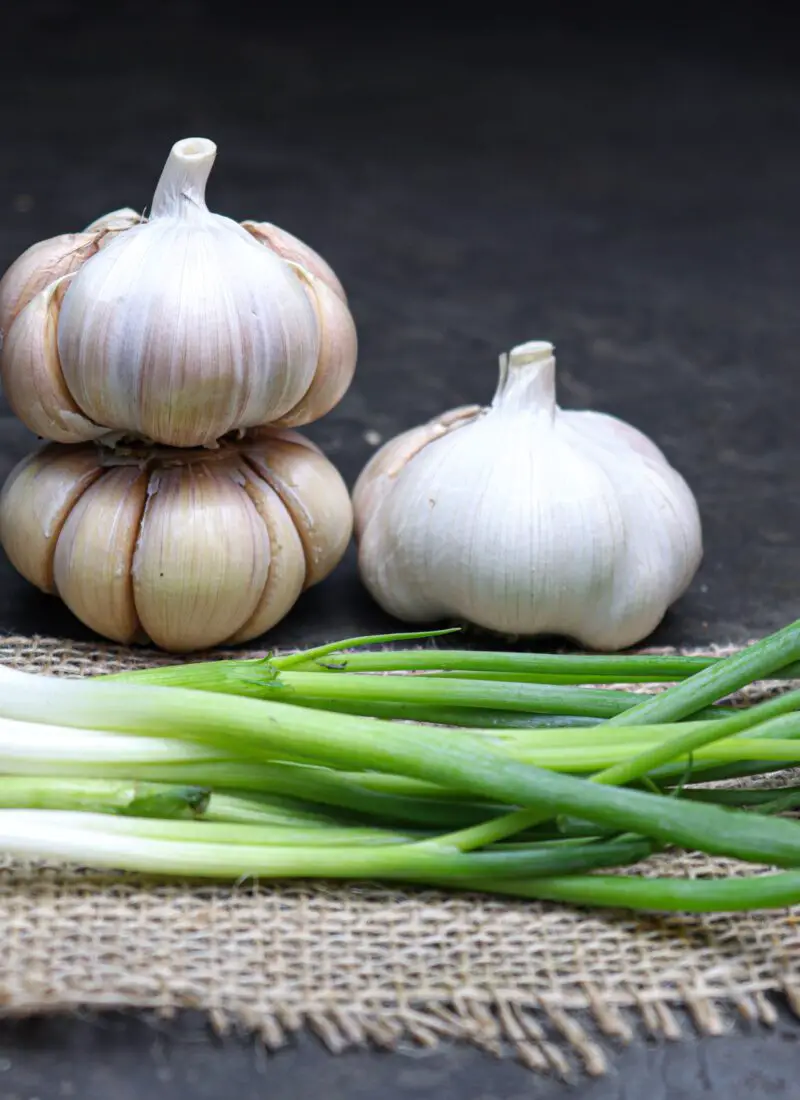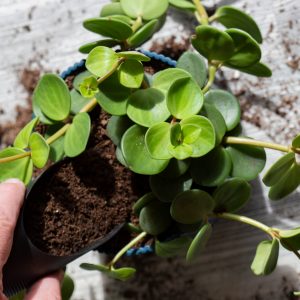
To the untrained eye, it’s just dirt and by-products. But to a gardener, it’s a canvas painted with various nutrients, each weaving its own intricate spell to encourage a plant’s growth. Yes, I’m talking about fertilizers and there are way more than you think there are!
Fertilizers primarily come in two types: organic and inorganic/synthetic. Both can nourish plants by providing nutrients needed to enhance their growth and promote optimal health. They can come in various forms, like liquid (fast-acting), granular (slow-release), and others (for specific needs).
Below, I discuss the different types of organic and inorganic/synthetic fertilizers that are both commonly used these days along with old forgotten ones:
(As an Amazon Associate, I earn from qualifying purchases.)
Organic vs Inorganic (Synthetic) fertilizers
Here is a quick pros and cons table of using organic fertilizers:
| Pros | Cons |
| Slow and steady release of nutrients. | Lower nutrient content compared to weight. |
| Improves soil structure and promotes microbial life. | Can be more expensive initially. |
| Generally eco-friendly and sustainable. | Might require larger quantities for the same effect. |
| Long-lasting effects due to slow decomposition. | Nutrient ratios can vary based on the source. |
| Derived from natural materials like compost, manure, bone meal, etc. | Some sources, like manures, might contain pathogens if not properly treated. |
And here is a quick pros and cons table of using inorganic/synthetic fertilizers:
| Pros | Cons |
| Fast and immediate release of nutrients. | High nutrient content; more concentrated. |
| Generally cheaper than organic options. | Can lead to nutrient runoff and water pollution. |
| Smaller quantities can achieve desired results. | Over-application can burn plants and harm soil. |
| Consistent nutrient ratios. | Does not significantly improve soil structure. |
| Effects can be short-lived; may require reapplication. | |
| Manufactured using chemical processes. |
Organic
This type of fertilizer comes from plant and animal resources, and are generally naturally occurring. They are often considered beneficial for plants because they provide a broad spectrum of nutrients and improve soil structure. They act like slow-release fertilizers, so you don’t have to top it off too frequently. Here are some common types of organic fertilizers:

- Manure. This is a byproduct of animal waste, often from cows, chickens, or horses. However, it’s essential to compost manure and age it before applying it to plants to kill any pathogens. I’d recommend getting Black Kow Manure from Amazon to get you started, especially if you’re growing plants in containers or raised container beds. It has a solid 1,003 ratings and 4.3 out of 5 stars.

- Compost. This is decomposed organic matter, usually made from kitchen scraps, yard waste, and other organic materials. You can easily DIY it at home, which you can find out about more in this composting article.

- Worm Castings. These are the waste products of earthworms. As icky as that sounds, they are actually rich in nutrients and beneficial microbes, making them an excellent soil conditioner. Why do you think gardeners love having them around? You can even collect your own by having a worm farm yourself, which you can read all about in this vermicomposting article. Alternatively, you can purchase Wiggle Worm’s Worm Castings from Amazon. It’s got 7,319 ratings with an impressive 4.7 out of 5 stars!

- Bone Meal. Just like its name, these are made from grounded animal bones. It’s a great source of phosphorus, which promotes root and shoot development. It also helps improve the fruiting quality of a plant. Although it’s worth noting that some pets like dogs will be attracted to the smell and dig up the soil. You can easily make your own at home but it’s better to get one from the store like Espoma’s Organic Bone Meal Fertilizer from Amazon. It’s got about 641 ratings with a not-too shabby 4.8 stars.

- Blood Meal. This is made from dried animal blood, which is a nitrogen-rich fertilizer that can help green up leafy plants. But just like Bone Meal, it may attract some animals that’ll mistake it for food. I’d highly recommend getting this Down to Earth Blood Meal from Amazon, which has 1,574 ratings with a decent 4.8 out of 5 stars.

- Fish Emulsion. This liquid mix is often made from processed fish but can also contain a variety of seafood too. It’s a balanced fertilizer that provides a quick nutrient boost to plants. But the smell is quite overpowering, and you can sometimes risk causing fertilizer burn to your plants with this, so only use it moderately. You can try this Alaska Fish Fertilizer from Amazon, which has 1,996 ratings and great 4.7 stars.
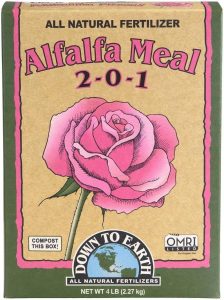
- Alfalfa Meal. This is made from fermented mature alfalfa plants and seeds and can come in pelletized and powdered form. The latter is more commonly used for plants, and requires careful handling by wearing a mask to prevent inhaling it. It’s also worth noting that this fertilizer is alkaline, and should not be used in acidic soil. I’d recommend using Down to Earth’s Alfalfa Meal Fertilizer from Amazon. It has 1,578 ratings with an average of 4.7 out of 5 stars.

- Cottonseed Meal. This is a by-product of cotton manufacturing, which is often used as slow-release fertilizer. It also helps to retain moisture and promote good air circulation in packed soil. It’s best used for plants that thrive in a slightly acidic soil environment, which is why you won’t really see much of it being used for most houseplants. If you are looking to use one, a good place to start is by using Down to Earth’s Cottonseed Meal from Amazon, which admittedly only has about 217 ratings and 4.7 stars.
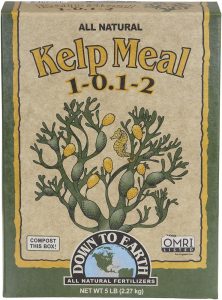
- Kelp Meal. This particular fertilizer is derived from brown seaweed with a bit of fishiness added at times. It’s often grounded and added into water, creating a liquid fertilizer that’s rich in micronutrients. Before using it, you’ll still need to dilute it in more water because it packs a solid punch. Some people recommend getting Maxicrop’s Kelp Meal because they’re pretty good. But I prefer using Down to Earth’s Kelp Meal from Amazon, which has 1,372 ratings with 4.8 out of 5 stars.

- Bat Guano. You guessed it, this is made from bat excrements, specifically from bat species that only feed on fruit and insects. It’s often used to enrich the soil and improve its structure and drainage. While it does have a bit of a stink, it can be used fresh, dried, or made into compost tea as a liquid fertilizer. I haven’t had a chance to use Sunleaves Bat Guano just yet, but this Down to Earth Bat Guano from Amazon works just fine. It has 2,054 ratings with a promising 4.7 stars.

- Rock Phosphate: This mineral-based fertilizer, also known as rock dust, provides a long-lasting phosphorus source for plants. It’s best used for flower and vegetable gardens, but has been known to be used for trees and lawns as well. Depending on some brands, they can come in dry or liquid form. You can try Down to Earth’s Rock Phosphate (1,032 ratings with 4.7 stars) if you want to give it a try in your garden.

- Feather Meal. This is made from processed poultry feathers that have been heat and pressure-treated before grounding into fine powder. It is a nitrogen-rich organic fertilizer that can boost leafy growth and improve soil structure. But it’s worth noting that they should be sourced from reputable farms with free-range policies, rather than factory-farmed ones. I’d recommend getting Down to Earth’s Feather Meal from Amazon, which has a decent 582 ratings and 4.7 out of 5 stars.
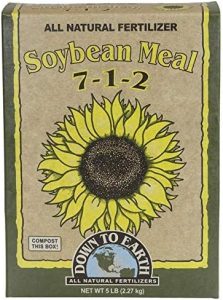
- Soybean Meal. This high-nitrogen fertilizer is the by-product after oil has been extracted from soybeans. Most people seem to have stopped using this particular fertilizer because it inhibits seed germination and general plant growth. Though some have attest that applying it weeks before planting will allow soymeal to break down first.

- Green Manure/Cover Crops. Now these natural fertilizers come in the form of plants that are grown and then tilled back into the soil. Not only do they improve soil fertility and structure, but some of them make pretty cover crops for your garden. You can find several seed choices from True Leaf Market, but if you’re unsure of where to start, alfalfa or clover seeds are your best bet.
Inorganic (Synthetic)

These fertilizer types are man-made compounds that provide instant, essential nutrients to plants. They are typically derived from mineral salts and are formulated to deliver specific nutrient ratios to crops. While they are faster-acting than organic fertilizers, they have been a subject of concern for a while now. This is mainly due to leaching and runoff that causes pollution in nearby water systems. They are also more often used for large-scale agriculture farming.
For your reference, here are some of the most common inorganic fertilizers, most of which are not as widely used anymore and are now considered as soil amendments rather than fertilizers:
| Fertilizer/Compound | Description |
| Ammonium Nitrate (NH₄NO₃) | A popular nitrogenous fertilizer that provides a quick release of nitrogen to plants. However, it can be hazardous if not stored properly due to its explosive nature. |
| Urea (NH₂CONH₂) | Another nitrogen-rich fertilizer, urea is often used in agricultural settings. It’s water-soluble and can be applied directly to the soil but is best introduced through irrigation systems to ensure it doesn’t convert to Ammonia gas. |
| Ammonium Sulfate [(NH₄)₂SO₄] | This fertilizer gives out both nitrogen and sulfur, but is mostly used as a fertilizer for alkaline soils. |
| Calcium Ammonium Nitrate | This fertilizer provides both calcium and nitrogen to plants, and is usually used in acidic soil and in place of ammonium nitrate where it is banned. |
| Diammonium Phosphate (DAP) | A primary source of phosphorus and nitrogen, DAP is essential for root development and energy transfer in plants. |
| Monoammonium Phosphate (MAP) | Similar to DAP, MAP provides phosphorus and nitrogen but in different ratios. |
| Triple Superphosphate | Highly concentrated in phosphorus, this fertilizer is essential for root development and flowering. It is often used as starter fertilizers in low pH soil. |
| Potassium Chloride (KCl) | A primary source of potassium, it’s vital for various plant functions including protein synthesis and photosynthesis. It’s particularly useful to use too when the chloride content in the soil is low. |
| Potassium Sulfate (K₂SO₄) | Provides potassium and sulfur, beneficial for growing fruits and vegetables. |
| Potassium Nitrate (KNO₃) | Supplies both potassium and nitrogen, aiding in plant growth and especially, fruiting. |
| Zinc Sulfate (ZnSO₄) | Essential for various enzyme activities involved in metabolic reactions for crops, particularly to corn and beans. |
| Iron Chelate | Used to treat iron deficiencies i.e. iron chlorosis in plants, restoring their natural leaf color and promoting healthy growth. |
| Copper Sulfate (CuSO₄) | Provides copper, which is essential for various plant processes including photosynthesis. Though it has been banned in some places because it is highly toxic to aquatic life. |
| Agricultural Lime (CaCO₃) | Used to raise the pH of acidic soils, and improve soil structure. |
| Gypsum (CaSO₄·2H₂O) | Supplies calcium and sulfur without altering soil pH. |
Frequently Asked Questions:

Can I fertilize my plants with coffee grounds?
Coffee grounds cannot be used as a fertilizer for plants, unless they have been composted first. With that said, they are a good source of carbon when used in composting piles. However, only use about 20% or less portions of coffee grounds to the total compost pile to prevent offsetting the composting process.
Which fertilizer is the best for different plants?
There is no one best fertilizer that can be applied to different plants at once. It varies based on their specific needs and types. For example, Nitrogen-rich fertilizers benefit leafy greens; Phosphorus is essential for flowering plants, and Potassium aids fruit and root development. Always refer to each plant’s specific requirements and conduct a soil test for precise recommendations.
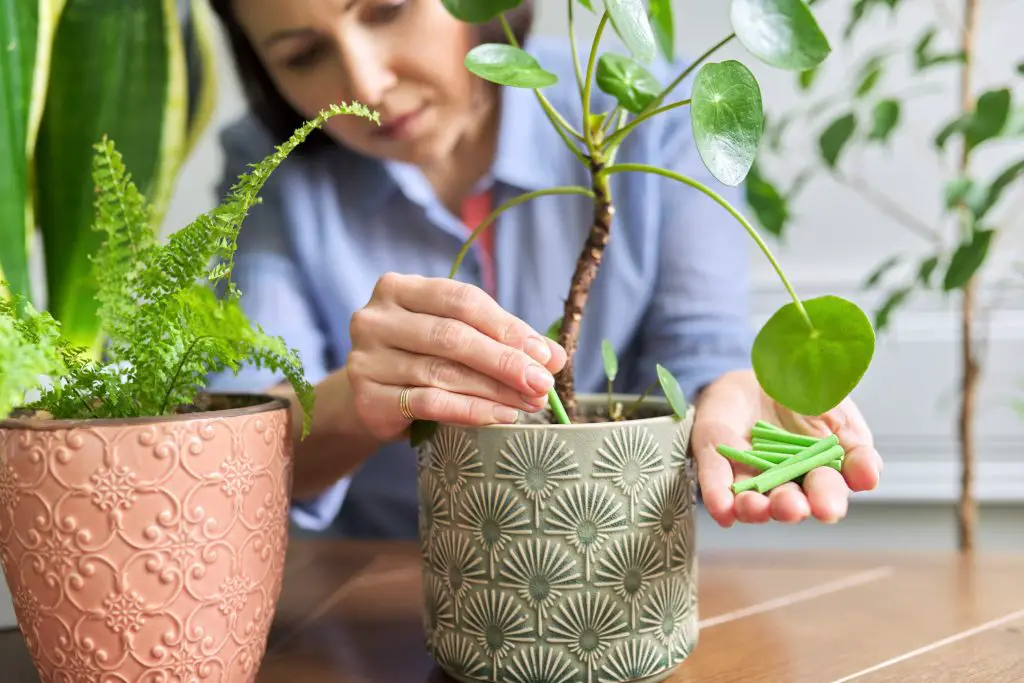
What is the best type/kind of fertilizer for indoor plants/houseplants?
A balanced, all-purpose houseplant fertilizer is the best type of fertilizer for indoor plants. They will usually be labeled as 20-20-20, indicating equal parts of Nitrogen (N), Phosphorus (P), and Potassium (K). However, do note that specific plants may need a different ratio of nutrients for their best growth. Always follow label instructions and avoid over-fertilizing the plants to prevent root burn.
How many times should you fertilize your plants?
Fertilizing once a year in spring and summer is recommended for most plants. However, it may widely vary depending on the season, plant type, soil quality, and the fertilizer used. For example, houseplants benefit from monthly to bimonthly fertilization during the growing seasons while outdoor plants may need it quarterly.

Which fertilizer is used for flowering plants?
Phosphorus-rich fertilizers are commonly used for flowering plants. These fertilizers are specifically designed to promote bloom and fruit production. A popular ratio is 10-20-10 (N-P-K), where N is nitrogen, P is phosphorus, and K is potassium, but it may always vary depending on the product and brand. As always, take care not to fertilize and only add when the plant has started flowering.
Should you fertilize new plants?
It’s not recommended to fertilize new plants before they are established. This applies to plants that have just been transplanted or repotted. They still need time to adapt to their new soil environment first and adding fertilizers may give them more stress than anything else.

Which type of fertilizer helps plants grow taller?
Currently, there doesn’t seem to be a specific type of fertilizer that helps plants grow taller. It mostly comes down to the type of plant, rather than its basic care. Although, some have claimed that giving it more light or Phosphorus-rich fertilizer may work but there’s no evidence to support this.
What is the most popular type of fertilizer?
Nitrogen-rich fertilizers like Urea are the most popular type of fertilizer used for plants. This is simply because Nitrogen is essential for plant growth and urea provides a concentrated source of nitrogen that is easily absorbed by plants. However, it’s more beneficial to use a balanced fertilizer that has equal amounts of Nitrogen, Phosphorus, and Potassium for most plant’s growth.
References:
- Clemson Cooperative Extension. (n.d.). Fertilizers. Home & Garden Information Center. Retrieved August 12, 2023, from https://hgic.clemson.edu/factsheet/fertilizers/
- Gardening Solutions – University of Florida, Institute of Food and Agricultural Sciences. (n.d.). Types of Fertilizer. Retrieved August 12, 2023, from https://gardeningsolutions.ifas.ufl.edu/care/fertilizer/types-of-fertilizer.html
- Michigan State University Extension. (n.d.). What organic fertilizers mean to plants and soil. Retrieved August 12, 2023, from https://www.canr.msu.edu/news/what_organic_fertilizers_mean_to_plants_and_soil
- NC State Extension. (2022, November 29). A natural fertilizer with phytotoxic activity. Retrieved August 12, 2023, from https://newcropsorganics.ces.ncsu.edu/organics/soybean-meal-fertilizer/
- Penn State Extension. (n.d.). Understanding synthetic, natural, organic, and chemical pesticide designations. Retrieved August 12, 2023, from https://extension.psu.edu/understanding-synthetic-natural-organic-and-chemical-pesticide-designations
- University of Maryland Extension. (n.d.). Garden fertilizer basics. Retrieved August 12, 2023, from https://extension.umd.edu/resource/garden-fertilizer-basics
- University of New Hampshire Extension. (2020, May). Is organic fertilizer better for lawns? Retrieved August 12, 2023, from https://extension.unh.edu/blog/2020/05/organic-fertilizer-better-lawns
- University of Utah Extension. (n.d.). Urea: A low cost nitrogen fertilizer with special management requirements. Retrieved August 12, 2023, from https://extension.usu.edu/yardandgarden/research/urea-a-low-cost-nitrogen-fertilizer-with-special-management-requirements
- Washington State University – Center for Sustaining Agriculture and Natural Resources. (n.d.). Organic and synthetic nitrogen. Retrieved August 12, 2023, from https://csanr.wsu.edu/organic-and-synthetic-nitrogen/



